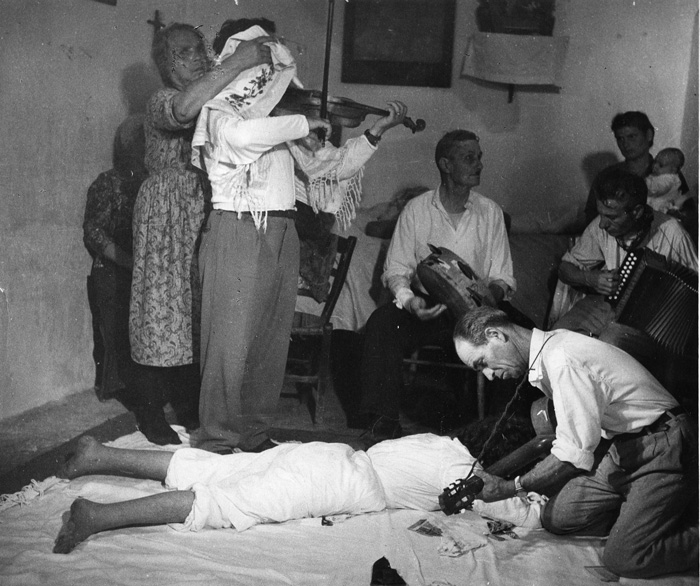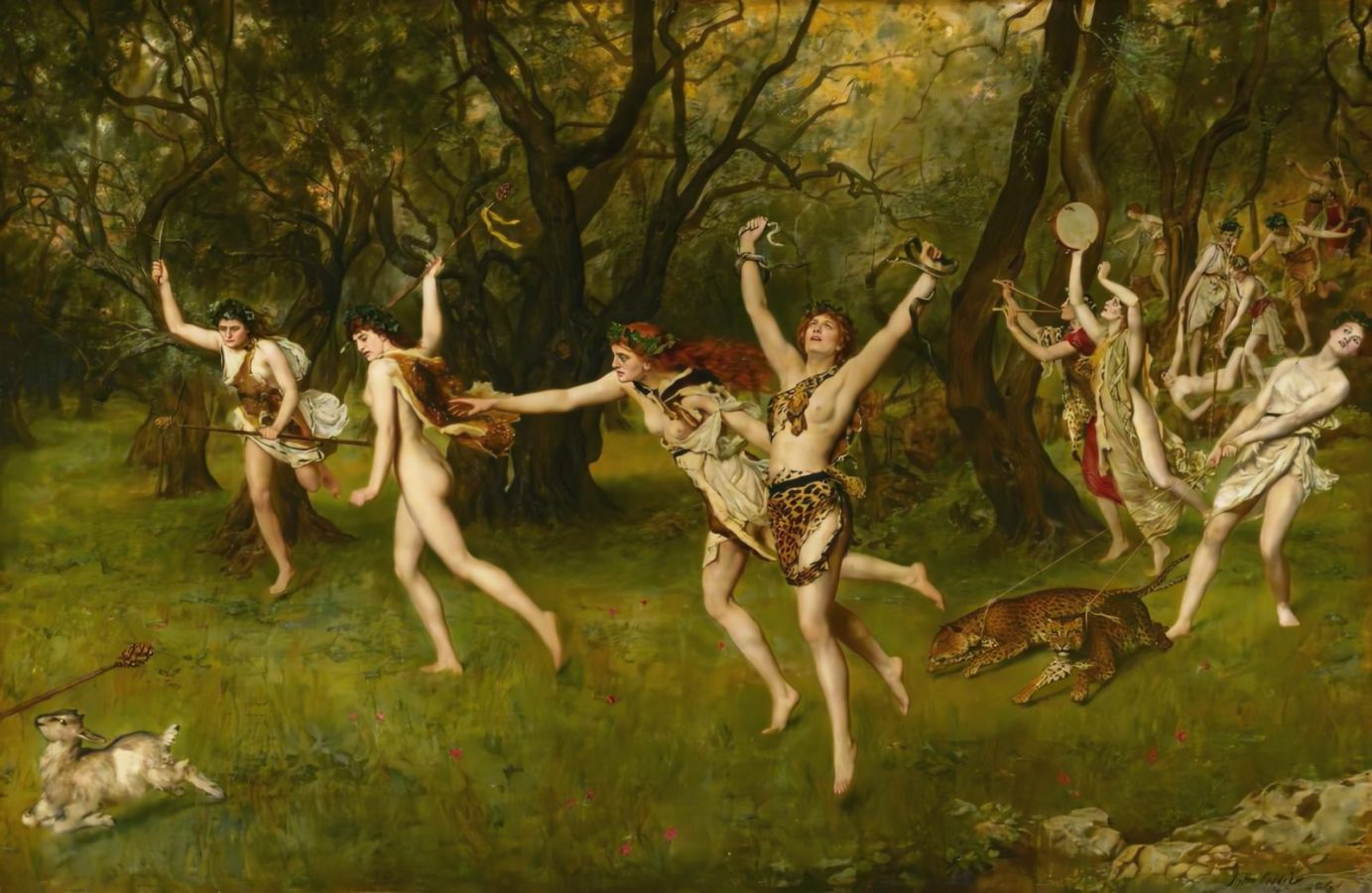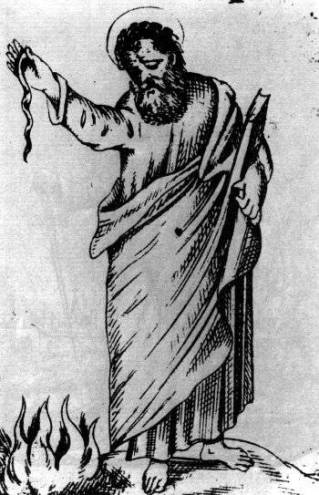TARANTISMO – A CULTURAL SYNDROME

TARANTISMO – A CULTURAL SYNDROME

Tarantismo is a traditional, societary and cultural phenomenon that existed mostly in the Salento region of Puglia, in Italy. It manifested mainly throughout harvest seasons and consisted in an hours-long rite, in which the victims of a spider’s bite (most frequently young women), were taken through a “Musical Exorcism”.
People “possessed” by the disorder could experience any number of symptoms like: abdominal pain, catalepsy, perspiration, palpitations and even hallucinations.
After hours of frantic dancing and squirming to the melodies and rhythm of the various Pizzica and Tarantella themes, weapons of choice for the musicians, the Tarantato (patient), extinguished all energy they still had and collapsed in exhaustion, symbolizing the success in curing the ailment.
 The origin of this rite is still unknown. Some of the oldest testimonies date back to the 14th century AD, when the first extensive written sources referring to it were found. Centuries later, even medical authorities agreed on the effectiveness of the musicianship in fighting off the Tarantola venom.
The origin of this rite is still unknown. Some of the oldest testimonies date back to the 14th century AD, when the first extensive written sources referring to it were found. Centuries later, even medical authorities agreed on the effectiveness of the musicianship in fighting off the Tarantola venom.
This spider, called Lycosa tarantula, is a type of wolf spider common in Southern Europe, especially along the Mediterranean, that got its name from the Apulian city of Taranto located in today’s region of Puglia.
Today we know that it is unlikely that this small creature (no more than 3 centimeters in length) was the cause of such a large scale phenomenon, since it is active mostly at night and lives in burrows.
A COBWEB OF CULTURAL INFLUENCES
For over two thousand years, the pagan genetics of Southern Italy (also referred to as Mezzogiorno or Meridione) have been sustaining many interesting beliefs and traditions.
Perhaps a trace of the Prehistoric creeds in the old continent, women seemed to take on a more important role in this phenomenon, as it was they that became afflicted most frequently (even though men could also suffer from the sickness). In reality, the most logical explanation to this might regard the fact that the ones who handled and processed the harvested grains in greater numbers were women. As a result, they were more exposed to the eventuality of a spider’s bite.
Moving forwards in time, to the age of the Ancient Greeks, we are able to find some more interesting symbolic connections through the cult of Dionysus: the Greek deity of wine and fertility. At the time of Magna Grecia (the name given to the ancient Greek colonies in south Italy), citizens celebrated gods and the prosperities attributed to them through rites, many of them held in spring or during season’s changes. Curiously enough, those were the times of the year when the manifestations of Tarantismo occurred most frequently.
This was also the craft of the Maenads, priestesses dedicated to Dionysus that exuberantly sprung into dance in order to honour their deity. These behaviours stemmed from ecstatic and emotional reflexes rather than being orderly rituals.

In fact, in some of his writings (Euthydemus), Plato explored the connection between the celebration of certain deities and the melodies associated to them. There’s the example of the musical healings of the Korybantes, priests dedicated to honouring Cybele (an ancient Greek deity), that via frantic dances and self-flagellation were believed to be able to cure patients that suffered from conditions like epilepsy.

Most recently, relatively speaking, it has been in Galatina (province of Lecce, in Puglia) where the most recognisable roots of this tradition have taken hold. Amongst the various monuments and rich heritage of the thousand-year-old region, in the heart of the Salento, one chapel stands tallest regarding this subject. The Cappella di San Paolo, built in honour of one of the town’s patron saints, was the place in which people who suffered from Tarantismo found their salvation.
According to an ancient legend, Galatina was the town where Saint Paul stayed, during one of his voyages of evangelisation in South Italy. He was kindly offered a place to stay by a local man, precisely where the chapel stands today. As a token of appreciation for his hospitality, the patron saint graced this simple man and his family with the ability to heal the sickness brought forth through the bite of venomous spiders. By using water from the well, that existed inside their home, and crossing their fingers along the wound, he and his kin were able to cure the condition. Indeed, Paul was an evangelist that was eventually canonized for his various feats. In one of his travels, after a shipwreck off the coast of Malta, he was bitten by a venomous snake while he was gathering up wood to light a fire. Even though locals feared for his death, no ill fate came upon Paul. He had been blessed with the abilities of god.
Fast forward to the 18th century, and on the precise spot where Saint Paul gave a simple man his blessing, the townfolk built a chapel to mark the importance of the miracle and the healing nature of the site. Since then, every year on the 29th of June, the day when the Saint is celebrated, large amounts of people from all over South Italy, went on pilgrimage to Galatina in search for the cure against Tarantismo, that ruined the lives of their dearest ones.
THE ECHOES OF THE PAST LIVE ON
Today, Tarantismo doesn’t have the same the same heavy influence on the social fabric and psyche of Salento, as it did in the past. However, it left some very strong marks on the Salentine society. A few videos and audio recordings of this phenomenon are still available today, along with depictions and writings of some specialists in the matter, such as the anthropologist Ernesto De Martino.
In a time when people faced with the unknown could only grab on to faith, it’s no wonder that, like a pot letting off steam, people experienced cathartic moments of release from their misfortunes and difficult lives.
 Today, The anima of the Taranta lives on in Culture in a different manner. Younger adults and teens have no memory of those events and their impact on society. Most of them have no contact with the lives of hard labour in agriculture that so many of their forefathers suffered through.
Today, The anima of the Taranta lives on in Culture in a different manner. Younger adults and teens have no memory of those events and their impact on society. Most of them have no contact with the lives of hard labour in agriculture that so many of their forefathers suffered through.
The new Tarantati are not possessed by anything or anyone. Like any of us they live through events and emotions that require processing and growth .
While commemorating their roots and carrying on their cultural heritage, people today gather in groups of hundreds, to proudly dance and sing the powerful sounds of the Pizzica and the Tarantella. To step and shrug misfortune away from daily life. Seemingly dancing in a trance, noone fears being seen or judged. A Culture that supports these marvellous expressions of humanity is nothing to be ashamed of. They are merely tools of self-expression that carry on the memory of an ancient land.
SOURCES
Websites:
A. (2020a, October 29). Il Tarantismo. Immagina Salento – Ti Guida Alle Vacanze Nel Salento. https://www.immaginasalento.it/guide/il-tarantismo/
araneae – Lycosa tarantula. (2020, June 21). Araneae. https://araneae.nmbe.ch/data/3977/Lycosa_tarantula
Calabrese, A. (2015, October 26). The Tarantula-Possessed Women Who Could Only Be Cured By Dance. Atlas Obscura. https://www.atlasobscura.com/articles/the-tarantula-possessed-women-who-could-only-be-cured-by-dance
CENNI SUL TARANTISMO – Canzoniere Grecanico Salentino. (n.d.). Canzonieregrecanicosalentino. https://www.canzonieregrecanicosalentino.net/cenni-sul-tarantismo/
Colomba, G. (2019, January 30). Origine del tarantismo. Cure-Naturali. https://www.cure-naturali.it/articoli/vita-naturale/spiritualita/origine-del-tarantismo.html
COME SI BALLA – Pizzica Pizzica. (n.d.). Sites.Google. https://sites.google.com/a/student.unife.it/pizzica-pizzica/come-si-balla
Degirmenci, E. (2020, November 2). The Women Blessed by Dionysus: Maenads. DailyArtMagazine.Com – Art History Stories. https://www.dailyartmagazine.com/dionysus-maenads/
Editore_sm. (2019, June 30). Alla scoperta del Salento: Santu Paulu miu de Galatina se ma fare la grazia fammela mprima. Corriere Salentino. https://www.corrieresalentino.it/2019/06/alla-scoperta-del-salento-santu-paulu-miu-de-galatina-se-ma-fare-la-grazia-fammela-mprima/
IL TARANTISMO. (2007, February). Due Passi Nel Mistero. http://www.duepassinelmistero.com/tarantismo.htm
K. (2020b, December 24). Il TARANTISMO. Karkum Project. https://www.karkumproject.it/tarantismo/
Martano, S. S.-. (n.d.). Festa dei Tamburellisti di Diso. Salentoviaggi.It. http://www.salentoviaggi.it/eventi/festa-dei-tamburellisti-di-diso.htm
Mascheroni, C. (2017, September 22). L’esorcismo nella cultura popolare: la storia del tarantismo. Midnight Factory – Il Male Fatto Bene. https://www.midnightfactory.it/blog/the-vatican-tapes/lesorcismo-nella-cultura-popolare-la-storia-del-tarantismo
Sanidopoulos, J. (2021, March 5). Saint Paul and the Snake of Malta. MYSTAGOGY RESOURCE CENTER. https://www.johnsanidopoulos.com/2011/01/saint-paul-and-snake-of-malta.html
Scremin, I. (2019, November 5). La pizzica e il tarantismo. LaTerradiPuglia.It. https://www.laterradipuglia.it/cultura-e-tradizioni/la-pizzica-e-il-tarantismo
Tarantismo in the land of Salento. (2014). Made in South Italy Today. http://www.madeinsouthitalytoday.com/tarantismo.php
The Editors of Encyclopaedia Britannica. (2020, February 23). Tarantella | dance. Encyclopedia Britannica. https://www.britannica.com/art/tarantella#ref186670
Trovasalento – Il Tarantismo. (n.d.). Trovasalento. http://www.trovasalento.it/informazioni/il_tarantismo/index.htm
Books:
La Terra del Rimorso, Contributo a una storia religiosa del Sud; 1961; D.E. Martino
Lo Sciamanismo e Le Tecniche dell’Estasi; 1953; M. Eliade
Sud e Magia; 1959; D.E. Martino







